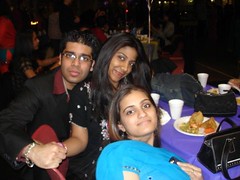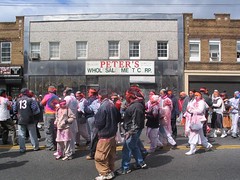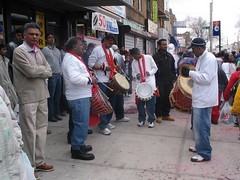|
|
Cultural EventsFrom The Peopling of New York City: Indian Communities
India is a largely diverse country, with many faiths and customs. The immigrants from the country reflect this diversity. However there is also a sense of unity that comes from a shared national identity, which some immigrants still feel toward India. This sense of national pride is reflected through cultural events such as Independence Day (August 15), or Republic Day (January 26) or the birthdays of such national (and international) heroes as Mahatma Gandhi (October 2). Such events are frequently hosted by independent organizations, and therefore may be somewhat private. The Consulate General of India in New York City hosts such events within its offices on 64th St, between Park and Madison Avenues. Other, more religious holidays are celebrated within the homes and communities of the varied Indian immigrant communities living in New York City.
Sikh Day Parade (April)The Sikh Day Parade in Midtown Manhattan is the only instance of a specific group of Indian immigrants coming out annually to celebrate their culture, religion and identity. Events at the parade include but are not limited to religious events, food, dance, general socializing. Eid (September/October)A sizable amount of the Indian immigrants in New York are practicing Muslims. Ramadan is a holy month for these immigrants, and after a month of serious fasting commemorating Prophet Muhammad's experience writing the Quran, and Eid is celebrated on the final day. Eid is a time for family and friends to come together around food and religion. During the month of Ramadan South Asian grocery stores (such as Patel Bros or Subzi Mandi) will sell such special items as dates, and holiday specific snacks and sweets with which to break fast (iftar). Diwali, the Festival of Lights (November)In November, the Hindu community celebrates Diwali, or Festival of Lights, for five days, while the Muslim community celebrates the end of Ramadan. This is a time of year where Indian immigrants can feel more at home: “Shristi Mittal, a Columbia student from Delhi, recently shopped at Foods of India for sweets and diyas, small pottery cups that are filled with wax or ghee and lighted at night during Diwali. (Diwali means row of lights.) 'If you have mithai and diyas, even a dorm room feels like India,' she said” "Festival of Lights, Parade of Sweets."
Holi/Phagwah, or Festival of Colors (March)Also known as the Festival of Colors, Holi is the Indo-Caribbean Hindu celebration of the arrival of spring that commemorates various events in Hindu mythology and is a time of disregarding social norms and indulging in general merrymaking. During Holi, which is the first Sunday after the full moon on the Hindu calendar, Hindus attend a public bonfire, spray friends and family with colored powders and water, and generally wild in the streets. The Phagwah Parade in Richmond Hill is the biggest celebration of the holiday in North America.
|




